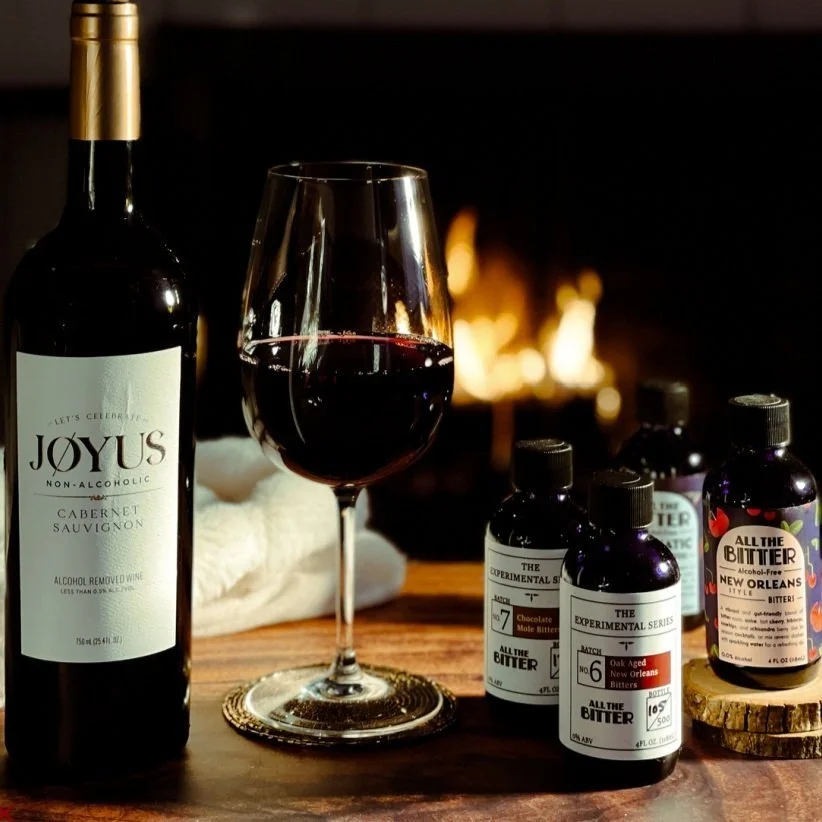Good, Bitter, Best: Non-alcoholic Drink Tastes Flat? Bitters To The Rescue
/Bitters have been around for hundreds of years, but what do they have to do with mocktails?
The bitters you might be familiar with are an alcoholic-substance that contains very concentrated levels of herbs and spices suspended in alcohol. A lot of classic cocktails use various forms or bitters to enhance their taste and experience. Bitters are so potent in flavor profile, only a few dashes of bitters are needed in most cocktail recipes. You may be familiar with Angostura bitters, which is the brand most often seen in bars and restaurants.
The secret that most people don’t realize is that adding bitters to a non-alcoholic cocktail or a glass of wine is like a magical transformation. People new to the non-alcoholic drinks category often report their drinks are flat - which generally means there’s either no bite to it or it’s not complex. Adding bitters helps bring back that complexity that people are looking for in their glass.
The controversy around bitters is they are usually 40% ABV (alcohol by volume) so anyone who cannot or does not want to have alcohol generally doesn’t want to consider using them. Although a few drops equals about 0.5% alcohol by volume or less it’s best to just find a new solution. This is why we are big fans of sommelier-founded brand All The Bitter, a line of alcohol-free bitters that will change the way you drink.
Using Bitters In Non-Alcoholic Wine
Non-alcoholic wine doesn’t always taste good to the newly initiated, particularly if you’re a regular wine drinker. The reasons for this are fairly simple: The alcohol molecule is notorious for holding on to the flavours that make regular wine complex, so when you remove alcohol from wine it takes those flavours and complexity with it. Modern innovation is pushing the boundaries of alcohol removal in wine, but it’s early days and those high-end products are also more likely to be small batch, high-priced and not accessible.
So what do you do if you’ve opened a bottle of non-alcoholic wine and you just don’t like how flat it is? Or there’s just something missing?
You add bitters.
What is the magic here? The complexity in the bitters is similar to the organic complexity that is a result of the natural grape, the fermentation process and the tertiary flavour adaptations like oak barreling. As mentioned, a lot of this gets removed through dealcoholization. The same process happens when bitters are manufactured. The organic material and functional herbs in bitters have their own aromas and flavours which are extracted by the solvent. Adding the finished bitters to wine enhances the liquid through their own complexity, and often complements the existing fruit notes and an extra juicy palette of non-alcoholic wine.
So next time you’re disappointed in a new bottle of non-alcoholic wine, add a few drops of All The Bitters (or any other type of bitters -your choice!) to your glass of wine and experience the magic!
Adding Bitters to Mocktails
Cocktail culture is full of recipes using bitters, and most bartenders wouldn’t live without a bottle of Angostura. There are hundreds of bitters on the market used by advanced mixologists, recipe developers and even at-home cocktail enthusiasts. Recipes are always enhanced by bitters.
Non-alcoholic cocktail culture has also embraced the use of bitters, particularly alcohol-free bitters like All The Bitter.
All The Bitters line includes aromatic, orange, peychauds and lavender, all of which have extensive abilities to shape-shift to whatever element is missing in your mocktail.
If you’re interested in how we’ve used bitters in our mocktails, click the button below for a selection of our recipes using All The Bitter.
We’d love to hear from you about how your using bitters in your non-alcoholic drinks! Add a comment below or email us and share your recipes. Cheers!





